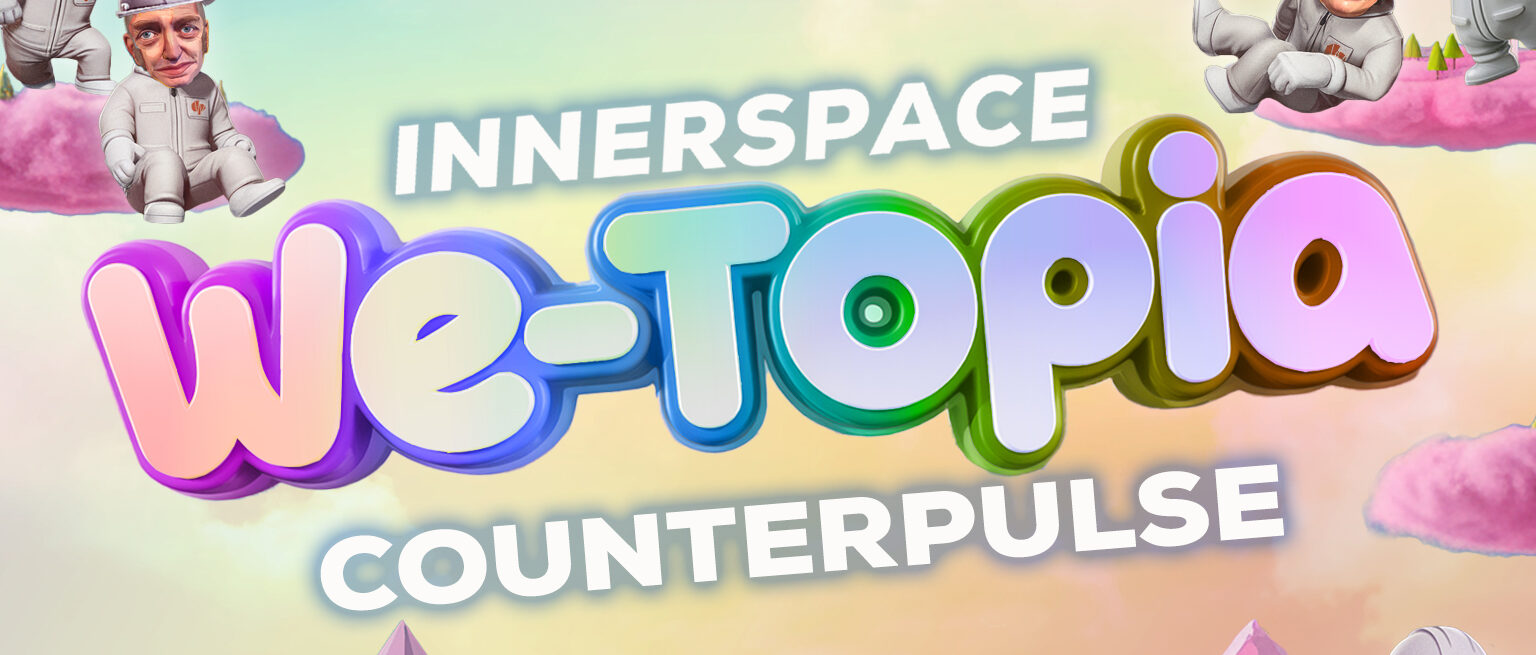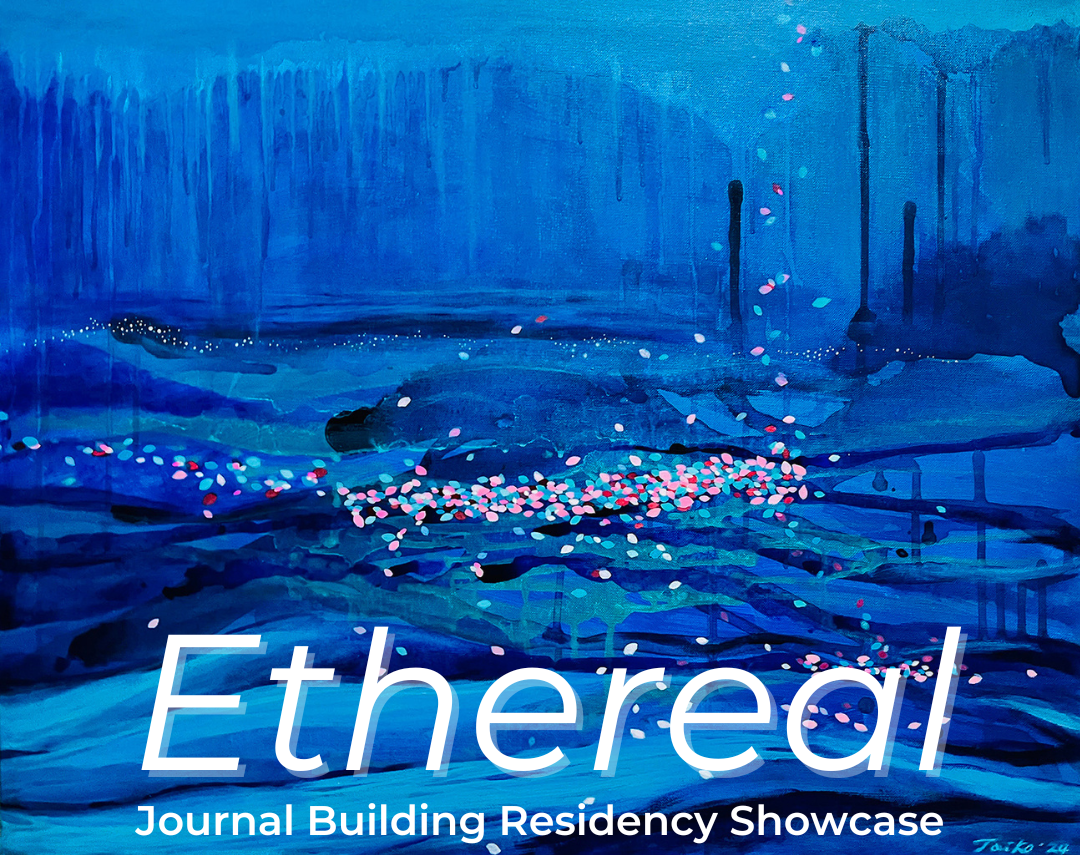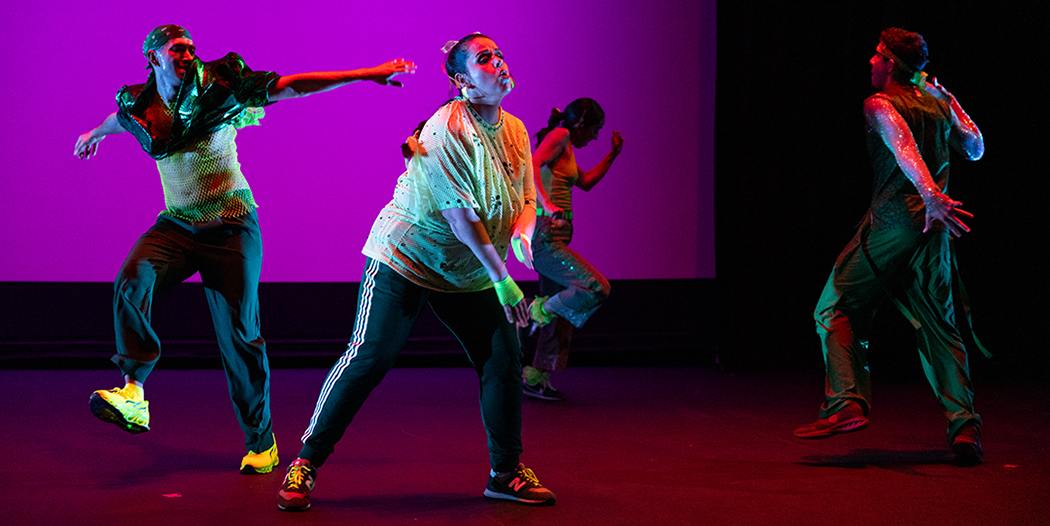How do you conjure queer ancestry through a dance performance? How can we form and unform psychic territories held through our lineages?
Randy Reyes’s new work borrows Chinese Energetics and systems of improvisation to weave queer ancestral lineages throughout an elaborate number. Lxs Desaparecidxs—created in collaboration with performers Jose Abad, Emelia Brumbaugh, Gabriel Christian, Felix (Sol) Linck Frenz, and Stephanie Hewett—is a work that seeks to inquire more than answer. Randy embarks on the rigorous process of asking around displacement, assimilation, decomposition, and queer futurism.
Together, the group is helping generate a movement that arises from responding to these questions. Collective inquiry drives spiritual resilience in Lxs Desaparecidxs, as the performers synchronize movement through a constellation of power dynamics and empathy. Through this, the dancers seem to organically become a single entity, as if bonded together through the unarchiving of Latinx and non-Latinx ancestries.
Randy’s dream, as identified on their Kickstarter page, is to “create a platform brings together queer Latinx and non-Latinx artists-activists-ecologists-spiritual thinkers from throughout the Americas together to address the function of performance, build a commons through the sharing of artistic, healing, and corporeal methodologies.”
I spoke with Randy on the thematic nature of Lxs Desaparecidxs and how the collaboration reverberates through socio-political dynamics of queer futurism, spiritual resilience, and tradition.
Justin Ebrahemi: Who is Randy Reyes? What is your dance/arts/performance background?
Randy Reyes: This is a very interesting question. The question is an ongoing excavation just like the process behind Lxs Desaparecidxs. Generally when asked this question, I identify as a choreographer-dance artist-healer.
In terms of my dance/performance background, I started out singing in the choir and doing pantomime performances at church (lol). I recall not being cast for one specific church performance and the disappointment that came along with it made clear to me how important moving my body was for me even at that age. In high school, I had some pretty bad-ass teachers (i.e. Della Schleunes & Kat Gurley) who exposed me to Hip-Hop, House, Contemporary, Chinese Traditional Dance, Floor-Work, and Choreography.
Because of my trajectory, I have never studied one form or genre for a long time. Initially, I thought this was detrimental because I felt confused about what I could share/teach, but then realized this shifting between genres was creating a more versatile corporeal repertoire/consciousness. To have the ability, as a mover/choreographer, to jump in and out of a score and drop into specific energetic states is my strength. To move from within to go out and out in all directions at once. The impossibility of the task creates a certain kind of tension and agency that I am particularly invested in. As I now find myself traversing the campus at UCLA during the first year of the MFA in Dance program here, I am specifically interested in implementing structures that connect Chinese Energetics, Martial Arts, Alexander Technique, Systems of Improvisation, Contemporary Dance, Body Weather Farm practices, Permaculture, Languages, Site-Specificity, and Ritual/Healing/Transformation.
JE: You work with 5 other performers in Lxs Desaparecidxs. Does the collaborative nature work to excavate themes around collective spiritual resilience, community traditions, and/or assimilation? How so?
RR: Definitely. Excavation is the key word here. The very first rehearsal started with us mapping the places where we come from, places we wished to go to, events that happened to us in these geographic locations or to the locations themselves, and then we collectively drew connections between our different trajectories. Afterwards, we lay around the map in a circle and meditated on the vision of the future world we wished to inhabit. What was the texture of this place? What things and people were here? What did the space taste like? What was the governing body of this place, if any?
The practice of mapping thoughts/questions and then embodying them has been a practice we have returned to often. There are literal scrolls we now have documenting each rehearsal we have had since May, which will somehow be woven into the December showings. This physical scroll becomes a part of the living archive for Lxs Desaparecidxs and becomes our collective book of spells for this December iteration and future iterations to come.

Randy Reyes, Jose Abad, Emelia Brumbaugh, Gabriel Christian, Felix (Sol) Linck Frenz, and Stephanie Hewett. Photo by Carmen Veronica.
JE: What is your personal connection to the collaborative? How did you all meet?
RR: The majority of us met this year through FRESH Festival workshops and performances. My lovely boo, Emelia, and I met at a residency called EMERGE which took place at Earthdance during the winter of 2015. I met Stephanie Hewett in NJ through my colleague/best friend, Malik Nashad Sharpe, who worked with Steph for his piece that premiered at Shuaspace, a gallery dance studio space in Jersey City, NJ.
Directing collaborative projects has been a part of my methodology for surviving in a new city and performance landscape. Lxs Desaparecidxs is essentially phase 2 of a larger umbrella project titled Barrio Cartography that I brought to fruition with a cast of artists from NYC.
I am very intuitive when it comes to choosing who I work with while at the same time feeling out energetically what configurations/constellations of people will generate fecundity, synchronicity, and dissonance. With both phase 1 and Lxs Desaparecidxs, I have been intentional about ensuring the cast I work with is as varied as possible with respect to varying perspectives, lineages, positionalities, aesthetic frameworks, and corporeal interests.
For me, the act of collaborating is a beautifully challenging one that is about temporarily surrendering the role of being director or lead choreographer. The ideas don’t solely belong to me now or ever or do they? I am open to being questioned and asked, “Why are we doing this?” In response I say, “What brought you into the room in the first place?” I am simply the initiator, facilitator, and connector of bodies in time and space and love to see the magic that happens over time.
JE: There’s an interesting play with syncopation of the dance vocabulary in Lxs Desaparecidxs. The performers shift their dynamics at specific intervals. There’s also this sort of language of caring in the movements, as performers respond (or don’t )to the collapse of one another. How does time and response inform the thematic content of this work?
RR: Personally, I am interested in thinking about ways to manipulate, stretch, and speed up time. I have been thinking about various forms of timing from how long it takes to drink a cup of water, to run across the stage, to melt to the floor, the speed of a car vs. a walking person vs. a helicopter. How do these various expressions of time and timing come into play within our performance? They do in some ways and in other ways they don’t. There IS a paradoxical sense of time especially in specific directives I offer such as speeding up inside while sustaining movement that traverses space as slow as possible; almost like a meditation.
There is one score in particular in Lxs Desaparecidxs that comes to mind relating to the themes of response and intimacy. The score involves one person in the group falling and we as a group have a specific set of choices we can make in relation to person who falls. One can step towards, turn away, assist, amongst other choices we are still figuring out. My reasoning behind this score was to illuminate a much larger societal paradigm that emerges when we as audiences/agents in our own lives choose to step into a situation and advocate for someone or ourselves or completely disassociate. The score is interested in rupturing this dichotomy/extremes of reaction and seeing what other potentialities for responding or presencing exist. Sometimes someone does fall in our lives and when this happens how we chose to react in that moment becomes one memory in the midst of thousands and thousands of other memories. There is something that happens to me when I see and hear the sound of a fleshy body hitting the earth over and over again. At which moment do I feel called to act? What are the systems of support we need and have developed? What strengthens or causes rupture in these networks/webs?
JE: Let’s get into frameworks. I read on your Kickstarter that your vision is to create a multinational movement that generates the force of love as a tool for surviving our current eco-socio-political climate. How does love as an interplay inform Lxs Desaparecidxs? As an inverse, does the work also conjure emotives around hatred?
RR: No, to the hatred portion of this question. There is already so much turmoil happening simultaneously around the world that I am not interested in having the work conjure or express more of what is already saturating our society. What I am interested in, however, is showcasing the potential ways rage/anger/dissonance can be channeled into a generative force and become another structure or way of perceiving reality. The process behind Lxs Desaparecidxs is structured in a way where we are actively practicing and using scores to engender a choreographic ecology. What I mean by this is that through various specific tactics including movement, writing, checking-in/listening, the cast and I are busy with generating a cartography that exists for the duration of the rehearsal and beyond.
As we listen to what is present for one another in the rehearsal, what we choose to share or not share inevitably enters the space. Through the act of moving and being in relation to one another these things we bring into the space become altered. This is what love is to me. It is a potent force that transforms what we bring into the space into a gem, into an offering, into a sacrifice. It is about the simple act of listening to someone with all of the senses and wondering what if through what we think we know about the senses another kind of sensing emerges?
JE: Tell me more about this movement. What does it take to participate?
RR: Because the vision that I have is such a large project, I have to break down the overarching dream of opening up an Escuela de Corporeidad y Artes Sutiles into many many many small steps. Completing my MFA in Dance program at UCLA is one of these many steps while traveling globally to connect and reconnect with artists who are committed to the values of choreography, ecology, and community engagement is a continual part of the process. What drives this project and everything that I do is my family’s narrative of migration from Guatemala to the United States. In the next years, I plan on traveling to Guatemala to see what happens to my body when I am there, where I am drawn to, who I meet, and let this be the choreography that leads me through my parent’s home country.
What it takes to participate is staying tuned for a developing website in the coming year, coming to performances, and connecting me to any resources or folks who are already invested in similar work to bring forces and energies together. I know I cannot do this alone nor am I unique in having this desire to bring something like this to fruition and thus call upon those who have come before me to help in the construction of this thing.
JE: Another CounterPulse resident artist, Clement Hil Goldberg, uses queer futurism as a framework to revive queer political imagination. Lxs Desaparecidxs draws on queer ancestries to “dance with ghosts”, but you also look toward the future by referencing queer futurism. How does this work resonate “queer futurist framewerqs”?
Through Lxs Desaparecidxs, we are offering proposals for what the future can look like by using elements from our present reality + our past hxstories to bring this future into existence. There is a prayer I make sometimes where I ask the ancestors who are guiding and protecting me to help me pull down the wisdom of the future into the present moment so that I can learn from what they did to develop and strengthen my resilience and sharpen my intuition. There was a moment when asking for spiritual guidance was not something I even believed in nor do I expect anyone to believe in it as well…I have the Bay Area to thank for this spiritual awakening of sorts.
Lxs Desaparecidxs is ultimately about generating hope and hope not only as, “I hope things get better,” and nothing gets done, but hope as an activating force that is connected to love and the power of the imagination and to spiritual resilience that is our truest essence. The power of the mind, psyche, thought-forms in relation to using this power to create the world I wish to live in is part of the practice for Lxs Desaparecidxs and future iterations of this project.
JE: How does Lxs Desaparecidxs balance past lineages with ideas around survival of the current/future eco-socio-political situation? Is there a harmony between unarchiving the past and looking toward the future that this work seeks to replicate?
RR: There was a section of Lxs Desaparecidxs titled End of the World and the premise behind this section was to imagine what the body experiences at the end of the world and what the process of restructuring would be like after the end of the world has taken place. Where to we start to rebuild and what structures do we need to implement to regain access to the basic resources we need to survive?
Lxs Desaparecidxs is inherently a piece about not knowing what to do with grief, the importance of developing a relationship to grief, letting go, shedding layers….Where are the spaces for collective grieving and what is the relationship grief has to joy?
I believe choreography is powerful in that it has the potential to present alternative realities that over time crumble the dominant mode of capitalist existence we currently find ourselves in. I believe that choreography and the act of witnessing performance can dramatically change an individual’s schema and what happens once another part of a person’s soul/body is awakened, only time will tell.
JE: Who do you think should see Lxs Desaparecidxs?
RR: Everyone! We had a beautiful comment in the second Works-in-Progress showing where someone in the room mentioned we should perform this work in various site-specific locations. I am excited by this possibility!
I wish my parents/family could come to the show. I mention them because they don’t have any knowledge of contemporary/experimental dance work and because of this I appreciate their comments, questions, and inquiries the most. What confused them? What struck something inside of them? What did they want to see more of? As folks who only speak Spanish, making my work accessible is important to me. I am interested in integrating the audience further and further into the performance structure for future choreographic investigations and iterations.
Randy Reyes is queer Latinx choreographer-dance artist-curanderx with roots connecting the geographies of Guatemala, Massachusetts, NYC, Germany, Chile, Ecuador, & Nicaragua. Their new work, Lxs Desaparecidxs, runs Thu-Sat, Dec 7-16 with “Pay what you can Thursdays” as a double-bill performance with Mother The Verb as part of CounterPulse’s Performing Diaspora 2017 residency.
Cover Photo by Robbie Sweeny.
Share This!
More Good Stuff
Thursday March 6th • 5PM - 10PM Step into a world where imagination shapes reality at CounterPulse’s annual gala! This year, INNERSPACE: We-Topia is
Ethereal: Market Street Studios Meet Tenderloin Stage San Francisco, CA — ArtSpan and CounterPulse are proud to present "Ethereal," a transformative group exhibition featuring works
Primera Generación Dance Collective is ready to be back in San Francisco! We are so excited to perform and be in community with our




